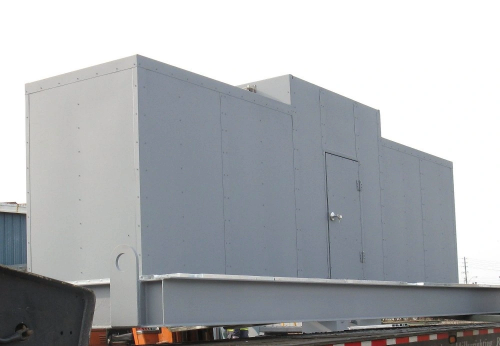

Guru Kripa Engineering is a leading Acoustic Enclosure For Chiller manufacturer in India. Chillers are vital components in industrial and commercial settings, maintaining optimal temperatures for various processes and equipment. However, the noise they generate can disrupt workplaces, affecting comfort and productivity. Acoustic Enclosure for Chiller offer an effective solution to mitigate noise levels while ensuring efficient operation. This article explores the benefits and considerations of implementing such enclosures.
Acoustic Enclosures for Chillers offer a practical solution to reduce noise levels and enhance workplace comfort and safety. By mitigating noise emissions and addressing regulatory compliance, these enclosures contribute to improved employee well-being and equipment performance. With careful planning and implementation, organizations can optimize chiller operation and productivity while creating a conducive work environment.
Benefits of Acoustic Enclosures for Chillers:
Noise Reduction: Acoustic enclosures effectively diminish chiller noise. By containing sound within the enclosure and using sound-absorbing materials like acoustic foam or fiberglass, noise levels are significantly reduced, fostering a quieter work environment.Improved Workplace Comfort: Excessive chiller noise can cause discomfort, stress, and reduced concentration among workers. Acoustic enclosures minimize noise disturbances, enabling employees to focus without hindrance.
Enhanced Safety: Prolonged exposure to high noise levels poses risks to workers’ hearing health. Acoustic enclosures mitigate this risk, ensuring compliance with safety regulations and preventing long-term hearing damage.
Equipment Protection: Acoustic enclosures safeguard chiller components from external disturbances and vibrations, extending equipment lifespan and reducing maintenance costs.
Energy Efficiency: Enclosures contribute to energy efficiency by reducing the need for additional cooling or ventilation systems, optimizing energy consumption, and potentially reducing costs.
Considerations for Implementation:
Design and Engineering: Collaborating with engineers and consultants ensures optimal enclosure design considering chiller size, airflow requirements, and maintenance access.
Material Selection: Choosing durable, fire-resistant, and effective sound-absorbing materials is critical for noise reduction and enclosure longevity.
Ventilation and Cooling: Proper airflow and cooling mechanisms within the enclosure prevent chiller overheating, ensuring optimal performance.
Maintenance Accessibility: Easy access for routine maintenance and inspection minimizes downtime and ensures continued performance and safety.
Design and Construction:
The design and construction of an acoustic enclosure are contingent on factors such as the desired level of noise reduction, the frequency range of the noise, and the specific requirements of the application. Considerations for proper ventilation and access points are integral to ensuring that the enclosed space remains functional while effectively controlling sound.
Functionality of Acoustic Enclosures:
Acoustic enclosures in India are engineered to employ sound-absorbing and sound-blocking techniques for effective sound control. The key operational aspects include:
Sound Absorption: The interior surfaces of the enclosure feature materials with high sound absorption properties, such as foam, mineral wool, or specialized acoustic panels. When sound waves enter the enclosure, these materials convert sound energy into heat through friction and internal reflection, reducing the sound’s intensity.
Sound Blocking: Walls, floors, and ceilings of the enclosure are constructed with dense and heavy materials like mass-loaded vinyl, composite panels, or thick glass to create barriers. These materials reflect and refract sound waves, preventing their transmission through the enclosure.
Sealing: Acoustic enclosures are meticulously sealed to minimize sound leakage, with gaps, joints, and access points sealed using acoustic caulking, gaskets, or weathers tripping.
Ventilation and Access Points: Proper ventilation and access points for equipment or personnel are maintained, with attention given to designing ventilation systems that allow airflow while minimizing sound transmission. Acoustic louvers or attenuators may be integrated into ventilation openings to reduce noise without compromising airflow. By employing these techniques.
An Acoustic Enclosure establishes a controlled acoustic environment. Sound-absorbing materials diminish sound intensity within the enclosure, while sound-blocking materials and effective sealing prevent sound from escaping or entering the enclosed space. This results in a quieter environment inside the enclosure, minimizing the impact of noise on the surrounding area.
